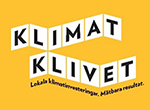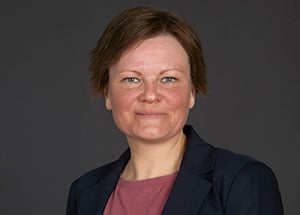Collaborations & EU projects
Ports of Stockholm’s international efforts aim to create beneficial conditions for the company's own business operations, which in turn benefit our customers, visitors and residents of Stockholm. Joint initiatives in areas that benefit the environment have been a specific focus in recent years. Collaborations and knowledge-sharing with other actors are essential to achieving change and development. Ports of Stockholm currently participates in the EU projects, partnerships and networks described below.
Current
Policy Lab Urban Zjöfart
Ports of Stockholm is participating, together with the companies Torghatten ASA, Zeabus, DNV Sverige AB and Vattenbussen AB, in the Policy Lab Urban Zjöfart project. Policy Lab Urban Zjöfart is a research and innovation project that is being coordinated by RISE Research Institutes of Sweden. The purpose of the project is to test the safety aspects of remotely operated (autonomous) water-borne public transport solutions based on the real-life example of the currently manned ferry service operating across Riddarfjärden in Stockholm.
The knowledge gained from the project in Stockholm will be evaluated in the context of the ongoing international policy work being carried out by the International Maritime Organization (IMO) and the European Maritime Safety Association (EMSA). The project aims to create new preconditions for sustainable mobility services and to strengthen Stockholm's commercial and regulatory position internationally.
Ports of Stockholm's role in the research project is to collaborate in testing and developing the safety aspects of innovative autonomously operated vessels. This is fully aligned with the City of Stockholm quays strategy, where research and development of urban shipping is a focus area.
The research project is running from February 2023 until February 2025. Ports of Stockholm has been awarded funding of around SEK 200,000 for the project from Swedish Transport Agency maritime transport research and innovation portfolio.
Coordinated supply of onshore power in Baltic seaports
Ports of Stockholm, together with three other Baltic Sea ports (Copenhagen/Malmö, Aarhus and Helsinki), is participating in the joint EU Coordinated supply of onshore power in Baltic seaports project. The aim of the project is to invest in onshore power connections to supply electricity to cruise ships. This is a joint initiative by the four Baltic Sea ports to reduce emissions of air pollutants from shipping within port areas.
For Ports of Stockholm the project involves equipping quay-berths S167 and S160 at Stadsgården with electricity connections for onshore power supply to vessels. This work will be completed in 2024.
For the project, which runs from 2020 to 2024, Ports of Stockholm has received EU grant funding up to a maximum of EUR 2.3 million from the Connecting Europe Facility (CEF) program.
The Stockholm aspects of the project have also been awarded significant local financial support from the Swedish Environmental Protection Agency's Climate Leap program.
 |
 |
Upgrade of the Baltic Sea bridge Kapellskär–Naantali – (MoS Finnlink)
Port of Kapellskär is participating, together with the Port of Naantali, in the EU project Upgrade of the Baltic Sea bridge Kapellskär–Naantali. This project has the goal of strengthening the links between the Port of Kapellskär and the Port of Naantali in Finland. The project involves investments in facilities to supply onshore electricity to vessels at the quayside. Among other benefits, this will reduce vessel air pollutant emissions in port areas. To meet customer demand for services and future needs, an auto-mooring capability will also be installed. A new passenger tower will also be built, the aim of which is to make embarkation and disembarkation easier for foot passengers.
For this project, which runs from 2020 to 2023, Port of Kapellskär has received EU grant funding up to a maximum of EUR 1.6 million from the Connecting Europe Facility (CEF) Motorways of the Seas program framework.
The project activities at the Port of Kapellskär have also been awarded funding from the Swedish Environmental Protection Agency's Climate Leap program.
 |
 |
BPO – Baltic Ports Organization
The Baltic Ports Organization represents the interests of ports in the Baltic Sea. The BPO plays an important role, for example when it comes to reaching a consensus on new regulations that exclusively concern the Baltic Sea region.
Link to BPO website (external link)
Cruise Baltic
Cruise Baltic is a collaboration of Baltic Sea cruise destinations with the objective of providing cruise options with fully integrated port and city operations.
Link to Cruise Baltic website (external link)
Cruise Europe
Cruise Europe is a network for the promotion of cruise ship traffic in Europe.
Link to Cruise Europe website (external link)
C40 Green Ports Forum
A forum in the form of a network of major cities throughout the world working to mitigate climate change was established in 2021. The Green Ports Forum is led by the Port of Los Angeles and aims to bring cities and ports throughout the world together for the common purpose of focussing on environmental and climate initiatives concerning shipping and port operational activities.
ESPO - European Sea Ports Organisation
The European Sea Ports Organisation represents all of the ports in EU member countries. ESPO ensures that the ports have a distinct voice within Europe.
Link to ESPO website (external link)
IACP/AIVP – International Association of Cities and Ports
The IACP/AIVP is an international network of public and private stakeholders involved in the sustainable development of port cities.
Link to IACP/AIVP website (external link)
IHMA – International Harbour Masters Association
The IHMA has the aim of promoting safe and efficient shipping in ports and related areas. The members of the organisation are mainly harbour masters from all around the world.
Link to IHMA website (external link)
PIANC – International Navigation Association
The PIANC works to support shipping by promoting the planning, design, construction, improvement, upkeep and operation of shipping lanes, ports and coastal areas, among other things.
Link to PIANC website (external link)
Ports of Sweden
The industry and employers' organisation Ports of Sweden represents the interests of all of the ports in the country.
Agreements with other ports
An important tool in being able to attain stringent environmental targets is to work together with ports from which there are regular sailings to Stockholm. Ports of Stockholm has signed joint initiative agreements with the Port of Helsinki, the Port of Turku and the Port of Tallinn to manage black and grey water and to provide electricity connections for vessels in port, among other things.
Completed
Intelligent Sea
Ports of Stockholm, together with Port of Naantali and the Finnish company Arctia (former Meritaito), participated in the joint EU project Intelligent Sea, which ran from 2018 to 2022. The project aimed to improve the safety and efficiency of maritime fairways through digitalization. In the project, floating as well as land-based aids to navigation were equipped with devices for remote monitoring and control as well as environmental sensors.
The fairway data produced by the aids to navigation are integrated with other fairway and port data by combining several data and control systems into a single digital service cloud. In addition, alternative energy sources were tested in the fairways.
The project was granted EU funding of maximum EUR 1,5 million from the EU programme Connecting Europe Facility (CEF).
NextGen Link
Ports of Stockholm, together with the Port of Turku, City of Turku, the Port of Mariehamn and Viking Line, participated in the joint EU NextGen Link Project that ran 2017-2021. The focus of the project was to upgrade Turku-Mariehamn-Stockholm shipping connections with a new LNG vessel and to improve infrastructure at the ports.
Viking Line ordered a new vessel, which meant an increased demand for freight handling and efficiency at the ports. Investments in port infrastructure were intended to meet this demand. For Ports of Stockholm the work involved the installation of a new ITS system (intelligent transport system) for efficient terminal operations and traffic control, as well as the creation of a new area for stacking and transit parking at the Stadsgården Port.
The project was granted EU funding up to a maximum of EUR 11.8 million from the Connecting Europe Facility (CEF) programme within the framework of Motorways of the Seas.

The Northern ScanMed Ports – Sustainable Maritime Links
Ports of Stockholm, together with Port of Turku, HaminaKotka, Port of Naantali and Viking Line ran an EU-financed project that aimed to develop environmental services in the ports and reduce the environmental impact from the traffic in the so-called Scandinavian-Mediterranean Corridor between Sweden and Finland.
Ports of Stockholm’s parts in the project were preparations for onshore power supply in Värtahamnen and Kapellskär and detailed designs for waste water management in Nynäshamn. The project was a Motorways of the Seas project within the Connecting Europe Facility and ran 2014-2016. Read more about the project (pdf)
![]()
LNG in Baltic Sea Ports
LNG in Baltic Sea Ports was an EU-funded project aimed at investigating the prerequisites for establishing a functional infrastructure for bunkering (refuelling) vessels with liquefied natural gas, otherwise known as LNG. The more stringent sulphur content restrictions for vessel fuels imposed by the International Maritime Organization (IMO) formed the basis for the project. LNG is one alternative to the heavy oils that are not allowed in the Baltic Sea anymore.
Ports of Stockholm was one of seven Baltic Sea ports involved in the project, which ran from 2012 to 2014.

